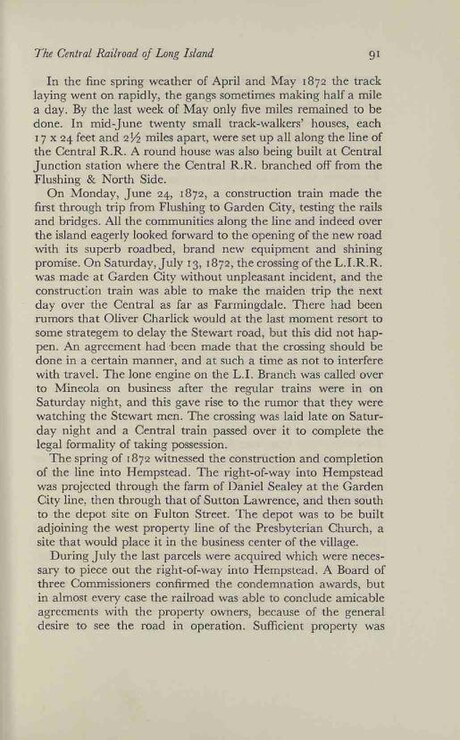In the fine spring weather of April and May 1872 the track laying went on rapidly, the gangs sometimes making half a mile a day. By the last week of May only five miles remained to be done. In mid-June twenty small track-walkers' houses, each 17 × 24 feet and 2½ miles apart, were set up all along the line of the Central R.R. A round house was also being built at Central Junction station where the Central R.R. branched off from the Flushing & North Side.
On Monday, June 24, 1872, a construction train made the first through trip from Flushing to Garden City, testing the rails and bridges. All the communities along the line and indeed over the island eagerly looked forward to the opening of the new road with its superb roadbed, brand new equipment and shining promise. On Saturday, July 13, 1872, the crossing of the L.I.R.R. was made at Garden City without unpleasant incident, and the construction train was able to make the maiden trip the next day over the Central as far as Farmingdale. There had been rumors that Oliver Charlick would at the last moment resort to some strategem to delay the Stewart road, but this did not happen. An agreement had been made that the crossing should be done in a certain manner, and at such a time as not to interfere with travel. The lone engine on the L.I. Branch was called over to Mineola on business after the regular trains were in on Saturday night, and this gave rise to the rumor that they were watching the Stewart men. The crossing was laid late on Saturday night and a Central train passed over it to complete the legal formality of taking possession.
The spring of 1872 witnessed the construction and completion of the line into Hempstead. The right-of-way into Hempstead was projected through the farm of Daniel Sealey at the Garden City line, then through that of Sutton Lawrence, and then south to the depot site on Fulton Street. The depot was to be built adjoining the west property line of the Presbyterian Church, a site that would place it in the business center of the village.
During July the last parcels were acquired which were necessary to piece out the right-of-way into Hempstead. A Board of three Commissioners confirmed the condemnation awards, but in almost every case the railroad was able to conclude amicable agreements with the property owners, because of the general desire to see the road in operation. Sufficient property was
